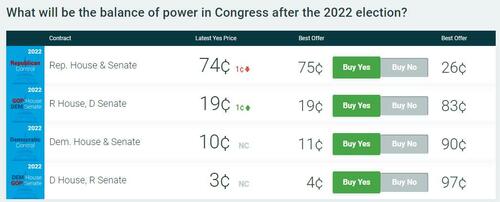From the Supreme Court today in Netchoice, LLC v. Paxton; this isn’t a decision on the merits, but only a decision on whether the Texas social media viewpoint neutrality law should be stayed pending appeal. The district court, which said the law was likely unconstitutional, had said stay; the Fifth Circuit, which hasn’t yet announced a decision on the merits, had said no stay; the Supreme Court, again without a decision on the merits, says stay (again, pending appeal).
Chief Justice Roberts, joined by Justices Breyer, Sotomayor, Kavanaugh, and Barrett voted to vacate the Fifth Circuit’s decision “staying the district court’s preliminary injunction.”
Justice Kagan voted to deny the application to vacate the stay (with no further comment).
Justice Alito, joined by Justices Thomas and Gorsuch, voted against a stay, and wrote this dissent:
This application concerns issues of great importance that will plainly merit this Court’s review. Social media platforms have transformed the way people communicate with each other and obtain news. At issue is a ground-breaking Texas law that addresses the power of dominant social media corporations to shape public discussion of the important issues of the day.
The law in question, HB20, regulates “social media platform[s]” that are “open to the public;” that “enabl[e] users to communicate with other users for the primary purpose of posting information, comments, messages, or images;” and that have at least “50 million active users in the United States in a calendar month.” Section 7 of HB20 prohibits these platforms from “censor[ing]” users based on viewpoint, and §2 requires covered platforms to disclose certain information about their business practices, including an “acceptable use policy” and “a biannual transparency report.” These platforms must also establish procedures by which users can appeal a platform’s decision to “remove content posted by the user.” …
To be entitled to vacatur of the stay, applicants must show, among other things, a “substantial likelihood of success on the merits.” Members of this Court have argued that a determination regarding an applicant’s likelihood of success must be made under “existing law.”
And whether applicants are likely to succeed under existing law is quite unclear.
The law before us is novel, as are applicants’ business models. Applicants claim that §7 of HB20 interferes with their exercise of “editorial discretion,” and they maintain that this interference violates their right “not to disseminate speech generated by others.” Under some circumstances, we have recognized the right of organizations to refuse to host the speech of others. See Hurley v. Irish-American Gay, Lesbian and Bisexual Group of Boston, Inc. (1995) (parade organizer); Miami Herald Publishing Co. v. Tornillo (1974) (newspaper). But we have rejected such claims in other circumstances. For example, in PruneYard Shopping Center v. Robins (1980), we rejected the argument that the owner of a shopping mall had “a First Amendment right not to be forced by the State to use his property as a forum for the speech of others.” And in Turner Broadcasting System, Inc. v. FCC (1994), we declined to apply strict scrutiny to rules that “interfere[d] with cable operators’ editorial discretion by compelling them to offer carriage to a certain minimum number of broadcast stations.” See generally E. Volokh, Treating Social Media Platforms Like Common Carriers? 1 J. Free Speech Law 377 (2021).
It is not at all obvious how our existing precedents, which predate the age of the internet, should apply to large social media companies, but Texas argues that its law is permissible under our case law. First, Texas contends that §7 does not require social media platforms to host any particular message but only to refrain from discrimination against a user’s speech on the basis of “viewpoint,” and in this respect the statute may be a permissible attempt to prevent “repression of [the freedom of speech] by private interests,” Associated Press v. United States (1945).
Second, Texas argues that HB20 applies only to platforms that hold themselves out as “open to the public,” and as neutral forums for the speech of others. {Texas also suggests that applicants’ position in this litigation is in conflict or tension with the positions of its members in cases regarding the interpretation of §230 of the Communications Decency Act of 1996, 47 U. S. C. §230. That statute directs, among other things, that “[n]o provider … of an interactive computer service shall be treated as the publisher or speaker of any information provided by another information content provider.” Texas claims that “[w]hen the platforms resort to section 230’s protections … they are relying on Congress’s determinations that they are not the ‘publisher’ of their users’ content, and that they are not ‘responsible’ for that content in any respect. And Texas suggests that, given that many of applicants’ members have emphasized their “‘neutral[ity]'” and their function as “‘conduits'” for the speech of their users, the Court should view their assertions of a First Amendment right to engage in “‘editorial discretion'” with some skepticism.} These representations suggest that the covered social media platforms—like the cable operators in Turner—do not generally “‘convey ideas or messages [that they have] endorsed.'”
Third, since HB20 is limited to companies with “50 million active users in the United States,” Texas argues that the law applies to only those entities that possess some measure of common carrier-like market power and that this power gives them an “opportunity to shut out [disfavored] speakers.” Turner; see also Biden v. Knight First Amendment Institute at Columbia Univ. (2021) (Thomas, J., concurring). If anything, Texas submits, its arguments regarding the constitutionality of §2’s disclosure requirements are even stronger. The State notes that we have upheld laws requiring that businesses disclose “purely factual and uncontroversial information about the terms under which [their] services will be available,” so long as those requirements are not “unjustified or unduly burdensome.” Zauderer v. Office of Disciplinary Counsel of Supreme Court of Ohio (1985). If we were to agree with the applicants’ arguments, the decision could have widespread implications with regard to other disclosures required by federal and state law.
The procedural posture of this case also counsels against vacatur of the stay. Applicants sought pre-enforcement review of the statute in federal court, so it is not clear how state courts would interpret this statute if it were applied to applicants’ businesses; nor has it been resolved which platforms are covered by the law. The statute also includes a broad severability provision, so vacating the stay requires a determination that applicants are likely to be able to show that every provision of HB20 is unconstitutional.
What is more, the attorney general’s enforcement power is limited to prospective relief … [—]”injunctive relief ” and, if granted, “costs,” “reasonable attorney’s fees,” and “reasonable investigative costs” …. In this respect, this statute is quite different from one that authorizes imprisonment or severe monetary penalties for those who refuse to comply. Should the attorney general bring an enforcement action for injunctive relief, applicants would then have an opportunity to argue that the statute violates the First Amendment, whether facially or as applied to them.
I reiterate that I have not formed a definitive view on the novel legal questions that arise from Texas’s decision to address the “changing social and economic” conditions it perceives. But precisely because of that, I am not comfortable intervening at this point in the proceedings.
While I can understand the Court’s apparent desire to delay enforcement of HB20 while the appeal is pending, the preliminary injunction entered by the District Court was itself a significant intrusion on state sovereignty, and Texas should not be required to seek preclearance from the federal courts before its laws go into effect. The Court of Appeals, after briefing and oral argument, concluded that the District Court’s order should be stayed, and a decision on the merits can be expected in the near future. I would not disturb the Court of Appeals’ informed judgment about applicants’ entitlement to a stay.
The post Supreme Court Reinstates Stay of Texas Social Media Law (Pending Appeal); Justices Alito Dissents appeared first on Reason.com.
from Latest https://ift.tt/6bk4Ws0
via IFTTT






